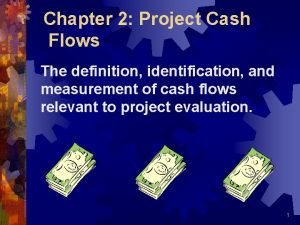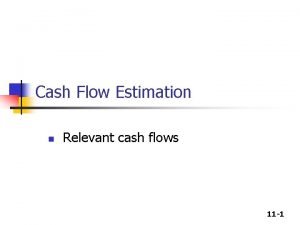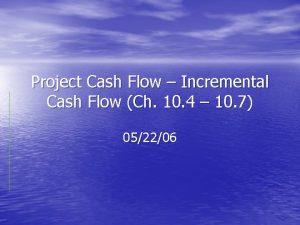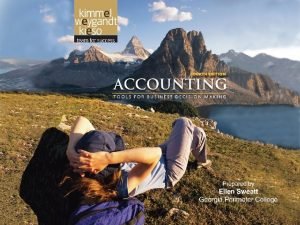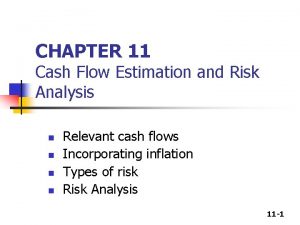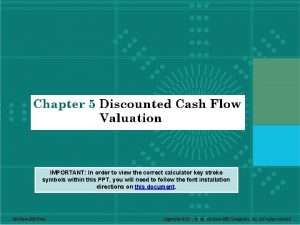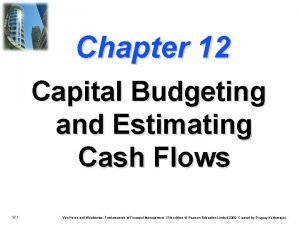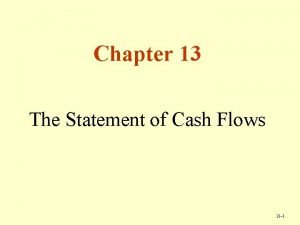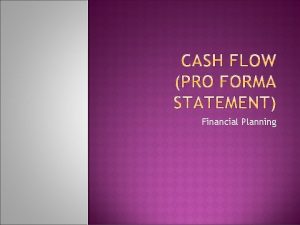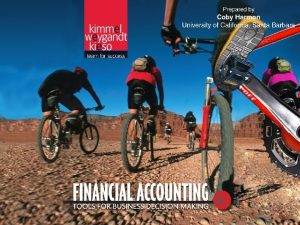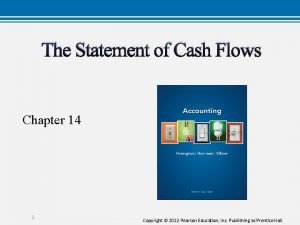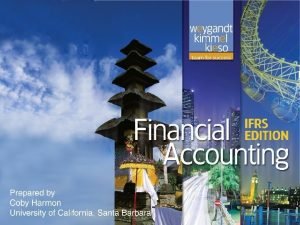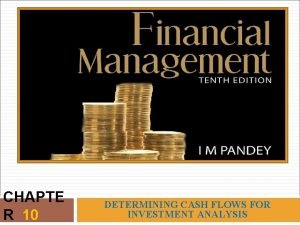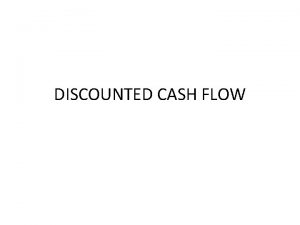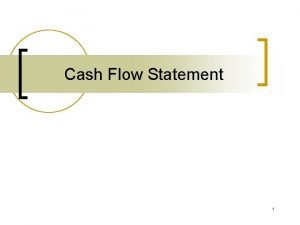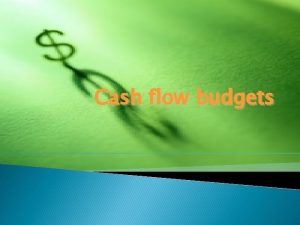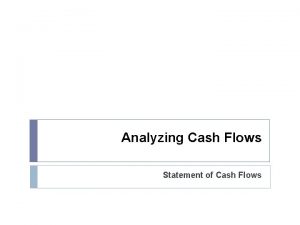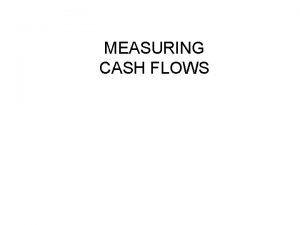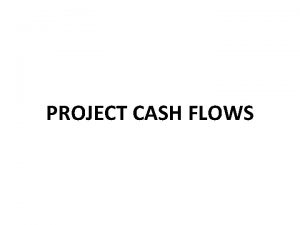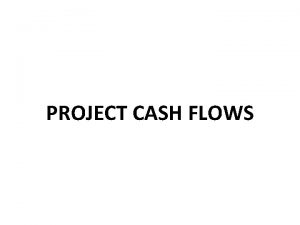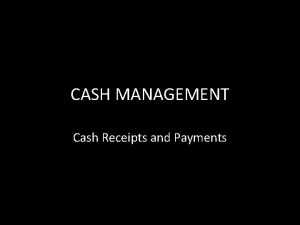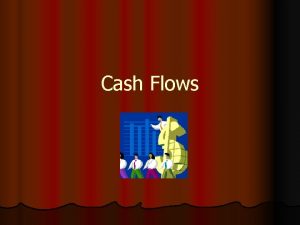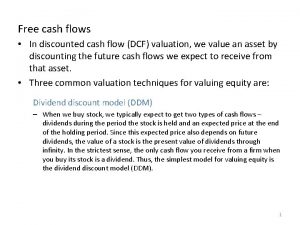Cash Flow Estimation n Relevant cash flows 11














- Slides: 14

Cash Flow Estimation n Relevant cash flows 11 -1

Proposed Project n Total depreciable cost n n Changes in working capital n n n Equipment: $180, 000 Shipping: $10, 000 Installation: $30, 000 Inventories will rise by $25, 000 Accounts payable will rise by $5, 000 Effect on operations n n New sales: 100, 000 units/year @ $2/unit Variable cost: 60% of sales 11 -2

Proposed Project n Life of the project n n n Economic life: 4 years Depreciation: Straight line method/reducing balance method. Salvage value: $25, 000 Tax rate: 40% WACC: 10% 11 -3

Determining project value n Estimate relevant cash flows n n n 0 Calculating annual operating cash flows. Identifying changes in working capital. Calculating terminal cash flows. 1 2 3 4 Initial Costs OCF 1 OCF 2 OCF 3 NCF 0 NCF 1 NCF 2 NCF 3 OCF 4 + Terminal CFs NCF 4 11 -4

Initial year net cash flow n Find Δ NOWC. n ⇧ in inventories of $25, 000 n Funded partly by an ⇧ in A/P of $5, 000 n n Δ NOWC = $25, 000 - $5, 000 = $20, 000 Combine Δ NOWC with initial costs. Equipment Installation Δ NOWC Net CF 0 -$180, 000 -40, 000 -20, 000 -$240, 000 11 -5

Determining annual depreciation expense 60 60 60 Year Rate x Basis Depr 1 0. 25 x $240 $ 2 0. 25 x 240 3 0. 25 x 240 4 0. 25 x 1. 00 240 60 $240 11 -6

Annual operating cash flows Revenues - Op. Costs (60%) - Deprn Expense Oper. Income (BT) - Tax (40%) Oper. Income (AT) + Deprn Expense Operating CF 1 2 3 4 200 200 -120 -60 -60 20 20 -8 -8 12 12 20 20 32 32 11 -7

Terminal net cash flow Recovery of NOWC Salvage value Tax on SV (40%) Terminal CF $20, 000 25, 000 -10, 000 $35, 000 Q. How is NOWC recovered? Q. Is there always a tax on SV? 11 -8

Should financing effects be included in cash flows? n n n No, dividends and interest expense should not be included in the analysis. Financing effects have already been taken into account by discounting cash flows at the WACC of 10%. Deducting interest expense and dividends would be “double counting” financing costs. 11 -9

Should a $50, 000 improvement cost from the previous year be included in the analysis? n n No, the building improvement cost is a sunk cost and should not be considered. This analysis should only include incremental investment. 11 -10

If the facility could be leased out for $25, 000 per year, would this affect the analysis? n n Yes, by accepting the project, the firm foregoes a possible annual cash flow of $25, 000, which is an opportunity cost to be charged to the project. The relevant cash flow is the annual aftertax opportunity cost. n A-T opportunity cost = $25, 000 (1 – T) = $25, 000(0. 6) = $15, 000 11 -11

Proposed project’s cash flow time line 0 1 2 -260 79. 7 91. 2 n 3 62. 4 Terminal CF → 4 54. 7 35. 0 89. 7 K= 10%. n n NPV = -$4. 03 million IRR = 9. 3% 11 -12

What is the project’s MIRR? 0 -260. 0 10% 1 2 3 79. 7 91. 2 62. 4 -260. 0 PV outflows $260 = $374. 8 (1 + MIRR)4 4 89. 7 68. 6 110. 4 106. 1 374. 8 TV inflows MIRR = 9. 6% < k = 10%, reject the project 11 -13

Evaluating the project: Payback period 0 1 2 3 4 -260 79. 7 91. 2 62. 4 89. 7 -89. 1 -26. 7 63. 0 Cumulative: -260 -180. 3 Payback = 3 + 26. 7 / 89. 7 = 3. 3 years. 11 -14
 Relevant cash flows definition
Relevant cash flows definition Relevant cash flows
Relevant cash flows Incremental cash flows
Incremental cash flows Which budget shows anticipated cash flows
Which budget shows anticipated cash flows Cash flow estimation and risk analysis
Cash flow estimation and risk analysis Annual interest rate
Annual interest rate Incremental cash flows
Incremental cash flows Operating activities vs investing activities
Operating activities vs investing activities The statement of cash flows classifies items as
The statement of cash flows classifies items as Cash flow pro forma
Cash flow pro forma What are plant assets
What are plant assets Statement of cash flows partial
Statement of cash flows partial Payback equation
Payback equation Chapter 13 statement of cash flows
Chapter 13 statement of cash flows Incremental cash flows definition
Incremental cash flows definition
